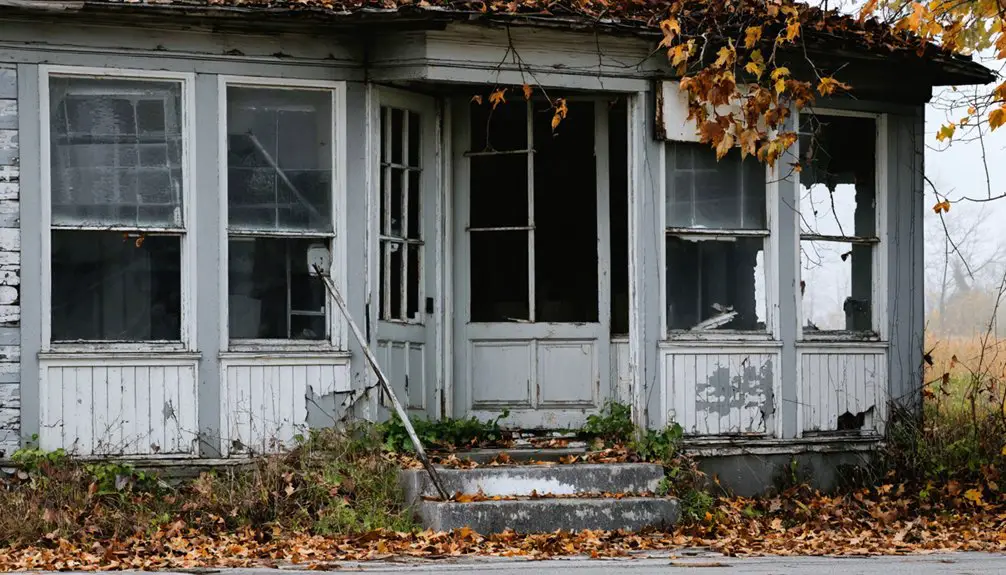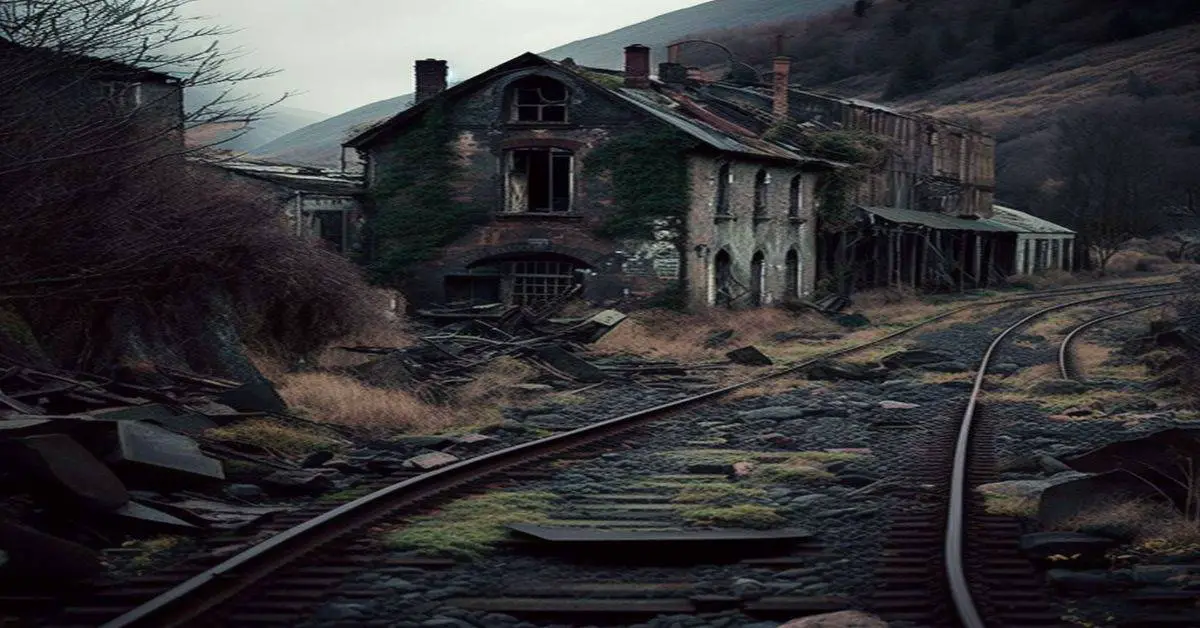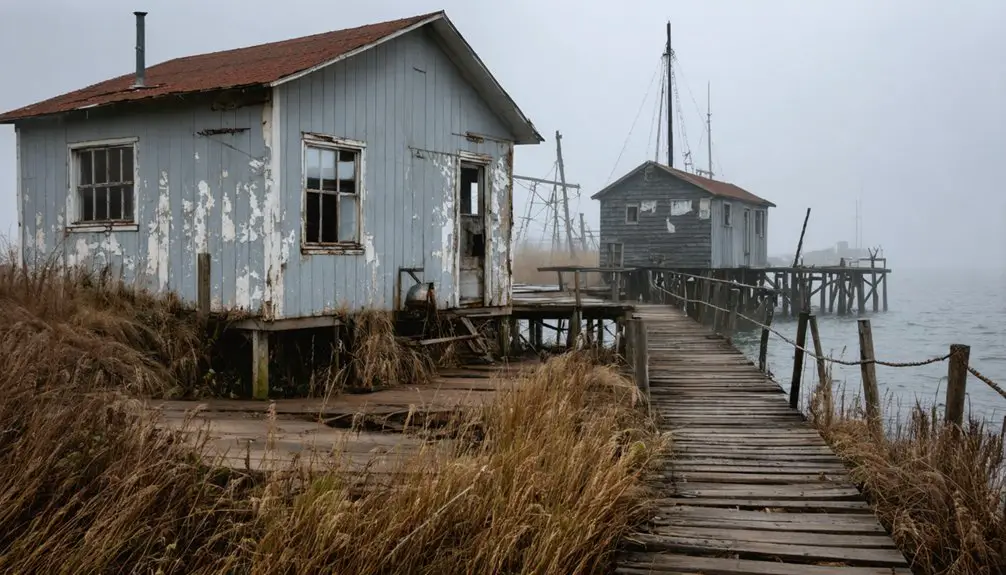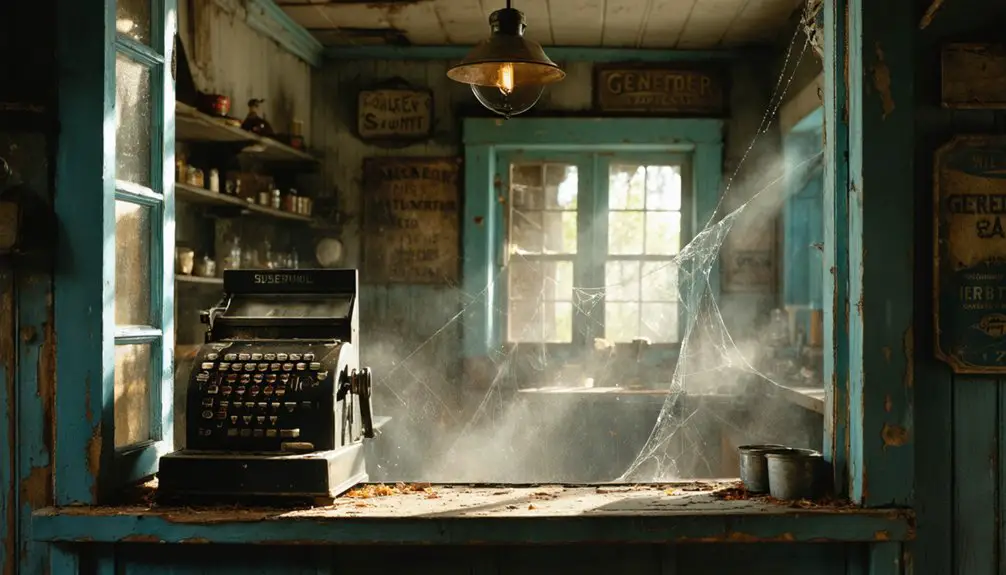You’ll find Delhi at the junction of Fox River and Waukau Creek in Wisconsin, where French-Canadian trader Luke La Borde established a thriving trading post in 1849. The settlement quickly grew to 150 residents by 1853, boasting multiple stores, sawmills, hotels, and a ferry crossing. Delhi’s prosperity faded when neighboring towns developed better infrastructure and railroads transformed the region. Today, scattered foundations and archaeological sites reveal this ghost town‘s fascinating frontier past.
Key Takeaways
- Delhi was founded in 1849 by French-Canadian trader Luke La Borde at the junction of Fox River and Waukau Creek in Wisconsin.
- The town flourished initially with multiple stores, sawmills, and hotels, reaching a population of 150 residents by 1853.
- Economic decline began when the town couldn’t fund essential bridge infrastructure, while neighboring towns Omro and Eureka developed better facilities.
- The arrival of railroads in the 1870s shifted trade routes and settlement patterns, contributing to Delhi’s eventual abandonment.
- Today, only scattered foundations, La Borde’s burial structure, and archaeological artifacts remain as evidence of Delhi’s brief but vibrant history.
The Rise of La Borde’s Landing
When French-Canadian trader Luke La Borde established his landing along the Fox River in 1849, he laid the foundation for what would become a bustling Wisconsin settlement.
You’ll find that his vision for the area, positioned strategically at the junction of Fox River and Waukau Creek, reflected common settlement patterns of the era. Similar to how the Yamuna River formed natural boundaries in India, the Fox River helped define the emerging community’s borders.
La Borde’s marketing savvy showed in his Oshkosh Democrat advertisement, where he highlighted the location’s natural beauty and commercial potential. To attract pioneer families with diverse motivations, he offered free lots measuring 66 by 132 feet to anyone willing to build within six months.
Free land and natural splendor were La Borde’s selling points, promising pioneers a fresh start on Fox River’s prime real estate.
The strategy worked – by 1850, the settlement boasted multiple stores, a public house, and two sawmills. A post office and ferry service soon followed, cementing the community’s growing importance. By 1853, the thriving community had grown to include over 30 dwellings and approximately 150 residents.
Life Along the Fox River
Life along the Fox River in Delhi centered on agriculture and commerce, with the waterway serving as the community’s lifeline.
You’d have found farmers implementing diverse farming techniques, cultivating winter wheat by 1837 and later specializing in hops production during the 1850s. The river ecology supported fertile soil conditions that enabled successful crop yields. Similar to settlers like George Fisher, who established the first farms, these early agriculturalists built the foundation for Delhi’s farming legacy. Nels Nelson Hersdal traded his 100 acres in New York to acquire 640 acres of prime farmland in the area.
You could’ve crossed the Fox River first by ferry, then later via a float bridge, connecting you to neighboring settlements and markets.
The riverside location wasn’t just about transportation – it powered the village’s steam sawmills and supported timber industries.
Norwegian immigrants particularly shaped the community, bringing their agricultural expertise to the Fox River valley. They established farming practices that helped transform Delhi into a thriving agricultural hub of the mid-19th century.
Commerce and Trade in Early Delhi
You’ll find that Delhi’s early commerce centered around its strategic position as a Fox River trading post, where Native Americans and settlers from nearby towns regularly exchanged goods.
The dock built for steamboat traffic enabled the import of supplies and export of local products, particularly the 200-pound hop bales bound for Oshkosh breweries. By the 1860s, Delhi had become a major agricultural hub with three hop mills and a hop press to process the region’s expanding crop.
Luke La Borde’s bridge construction further enhanced Delhi’s trading capabilities by connecting merchants to the grist mills in Waukau and expanding regional commerce networks. The ambitious founder initially purchased 140 acres of land to establish the burgeoning trading town.
River Commerce Activities
As Native American tribes established extensive trade networks along the Fox-Wisconsin Riverway more than 3,000 years ago, they created a commercial foundation that would later shape Delhi’s development.
You’ll find that by 1849, Delhi (La Borde’s Landing) had transformed into a bustling river trade hub with steam sawmills, hotels, and commercial stores serving the growing community of 150 residents.
Delhi’s merchants capitalized on the movement of diverse goods – from locally grown hops to lumber products and iron supplies. The town’s strategic location between the Mississippi River and Great Lakes positioned it well for commerce. Historical documents discovered through UW Digital Collections provide detailed records of the town’s trading activities.
However, Delhi’s economic decline began when it couldn’t fund essential bridge infrastructure, causing trade to shift to neighboring towns like Omro and Eureka that built better river crossings.
Fox River Trading Post
The Fox River Trading Post‘s story began in 1846 when French Canadian trader Luke LaBorde purchased a small outpost from William Powell.
You’ll find this trading post sat strategically between Omro and Eureka, at the junction of the Fox River and Waukau Creek. LaBorde renamed the settlement Delhi in 1848 after patenting 145 acres.
The trading post quickly grew into an economic hub, serving Native Americans and settlers alike. The location’s significance was enhanced by its placement on an ancient Indian burial ground.
By 1850, you’d have seen a bustling community with multiple sawmills, hotels, and a ferry crossing. Trade focused on agricultural products, lumber, and essential supplies that LaBorde brought from Green Bay.
The post office’s establishment in 1850 further cemented Delhi’s position as a crucial commercial center, though its prosperity wouldn’t last against competition from neighboring towns.
The Impact of Railroad Development
While northern Wisconsin remained largely undeveloped in the mid-1800s, railroad expansion transformed the region’s economic landscape beginning in 1870. The Wisconsin Central Railroad’s construction of 250 miles of track from Menasha to Ashland proved essential in reshaping settlement patterns, as new communities sprang up around rail stops instead of traditional river locations.
You’ll find the railroad’s significance extended beyond mere transportation. It claimed substantial government land grants, which attracted settlers to establish farms and sawmills near the tracks. Iron ore transport became a vital revenue source as timber profits declined over time. Judge Reed’s financing helped launch the ambitious railroad project that would connect these frontier regions.
These new settlements, like Station 51 (later Colby), flourished with improved access to markets and supplies. Despite financial setbacks during the 1870s and 1893 Panic, the railroad’s presence continued to drive regional growth, connecting isolated communities to urban centers and establishing critical economic corridors that shaped northern Wisconsin’s development.
A Community Lost to Time
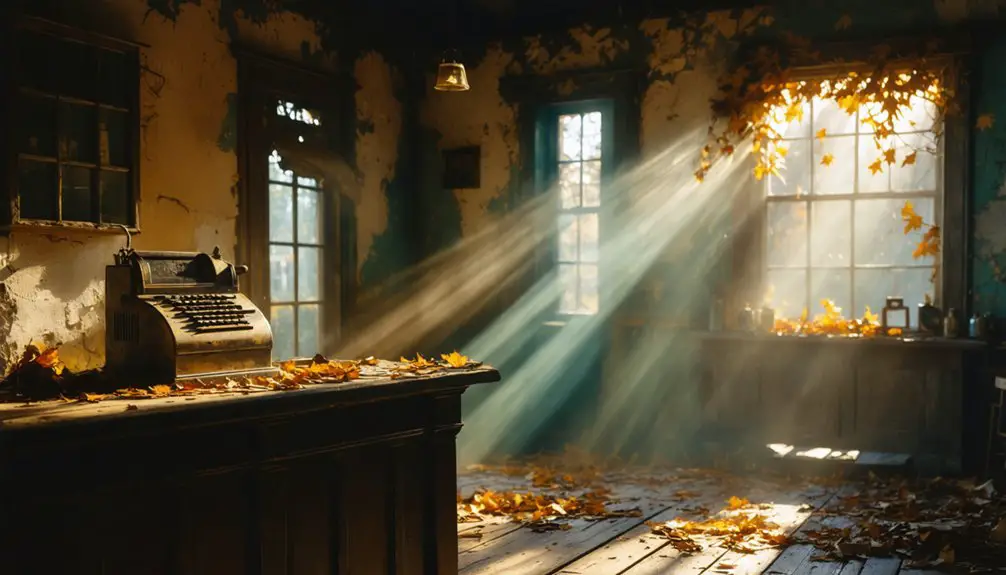
Originally named La Borde’s Landing, Delhi emerged in 1848 when French Canadian trader Luke LaBorde established a trading post at the confluence of the Fox River and Waukau Creek in Winnebago County, Wisconsin.
You’ll find traces of a rich cultural heritage in the artifacts discovered at this former Native American burial ground – trade beads, pottery, guns, and copper items that tell stories of both indigenous peoples and early settlers.
The community’s identity centered around river trade and hop farming, but prosperity proved fleeting. As neighboring towns Omro and Eureka grew stronger with better bridges and railroad connections, Delhi’s residents gradually departed.
Delhi’s Historical Legacy Today
Today you’ll find Delhi’s archaeological remnants scattered across its historic site, including Native American artifacts, pottery shards, and trade goods now preserved at the Oshkosh Public Museum.
While Luke LaBorde’s burial building stands as the last original structure, you can still trace building foundations and the old cemetery that mark this once-thriving settlement.
You can experience Delhi’s rich history through guided tours of the site, where educational programs help bring the ghost town’s past to life.
Archaeological Sites Remain
Despite Delhi’s abandonment, the ghost town‘s archaeological sites offer a rich historical tapestry through numerous artifacts and burial grounds.
You’ll find evidence of the town’s archaeological significance in pottery, beads, guns, and copper items that suggest a thriving trade network. The site’s burial artifacts, managed by the Oshkosh Public Museum, tell stories of both Native American settlements and European pioneers like the LaBorde family.
- Spring plowing has revealed skeletons, beads, and valuable artifacts from the Indian burial ground
- The LaBorde family burial structure still stands, though deteriorating
- The location at Fox River and Waukau Creek junction showcases trade-era remnants
The National Register of Historic Places now protects these archaeological treasures, ensuring Delhi’s story lives on through its material remains.
Historic Building Foundations
While many artifacts lie beneath Delhi’s soil, the town’s most visible historical remnants are its scattered building foundations and the solitary La Borde burial structure.
You’ll find these foundations scattered throughout the original townsite, marking the locations of former frame houses, sawmills, and hotels near the Fox River and Waukau Creek junction.
The archaeological significance of these ruins helps identify key economic structures, including La Borde’s store and ferry facilities.
Despite their historic preservation value, these mid-19th century foundations face ongoing threats from natural degradation and riverbank erosion.
When neighboring towns gained railroad access, Delhi’s buildings fell into disuse, leading to their eventual abandonment.
Today, these foundation remnants serve as silent witnesses to the town’s brief but vibrant trading history.
Tourist Educational Opportunities
Delhi Ghost Town draws visitors into its rich historical narrative through diverse educational experiences.
You’ll discover the 19th-century trading post‘s legacy through guided tours that showcase Luke LaBorde’s impact on regional commerce. The Oshkosh Public Museum‘s educational programs connect you with authentic artifacts, while interpretive trails lead you through the town’s original street layout.
- Experience hands-on history with pottery, beads, and copper artifacts that tell Delhi’s trading story
- Follow marked trails through former streets like Broadway and Main, with detailed signage explaining the town’s infrastructure
- Participate in historical reenactments that bring to life the French Canadian and Native American cultural blend
Preservation efforts guarantee you can explore Delhi’s remaining structures safely, including LaBorde’s burial cabin, while learning about the town’s eventual decline due to railroad developments.
Frequently Asked Questions
Are There Any Surviving Photographs of Delhi During Its Peak Years?
You won’t find surviving photographs from peak years, despite extensive archival research. Neither vintage postcards nor documented images exist, though you might discover undocumented photos in private collections or regional archives.
What Happened to Luke Laborde’s Descendants After Delhi’s Abandonment?
Like scattered seeds in the wind, LaBorde’s descendants drifted away from their roots. You’ll find their family connections dimmed as they likely moved to thriving nearby towns, leaving the LaBorde legacy largely untraceable.
Were There Any Schools or Churches Established in Delhi?
You won’t find any school history or church records from this settlement, as historical documents don’t show evidence of either institution being established during the town’s brief trading post existence.
Did Any Notable Crimes or Mysteries Occur in Delhi?
You won’t find any documented unsolved mysteries or criminal activities in the records. Historical accounts focus solely on the town’s economic decline and the Indigenous artifacts discovered during farming.
Can Visitors Access the Original Delhi Site Today?
Like stepping through time’s doorway, you’ll find no access restrictions at the site. You can freely explore the remaining structures and historical markers, though you should exercise caution due to deterioration.
References
- https://lakecountrytribune.com/exploring-the-haunting-echoes-of-wisconsins-ghost-towns/
- https://en.wikipedia.org/wiki/Delhi
- http://sites.rootsweb.com/~witttp/delhigt.htm
- http://oshkoshbeer.blogspot.com/2014/08/the-ghost-hops-of-delhi.html
- https://www.jstor.org/stable/4631983
- http://wisconsinology.blogspot.com/2008/02/ghost-towns-1delhi-wisconsin.html
- https://www.loquis.com/en/loquis/6534259/Delhi+Wisconsin
- https://www.dcnyhistory.org/books/mundel.html
- https://en.wikipedia.org/wiki/Fox_River_Settlement
- https://www.formycousins.com/1878/1878atlas-Winnebago.html
